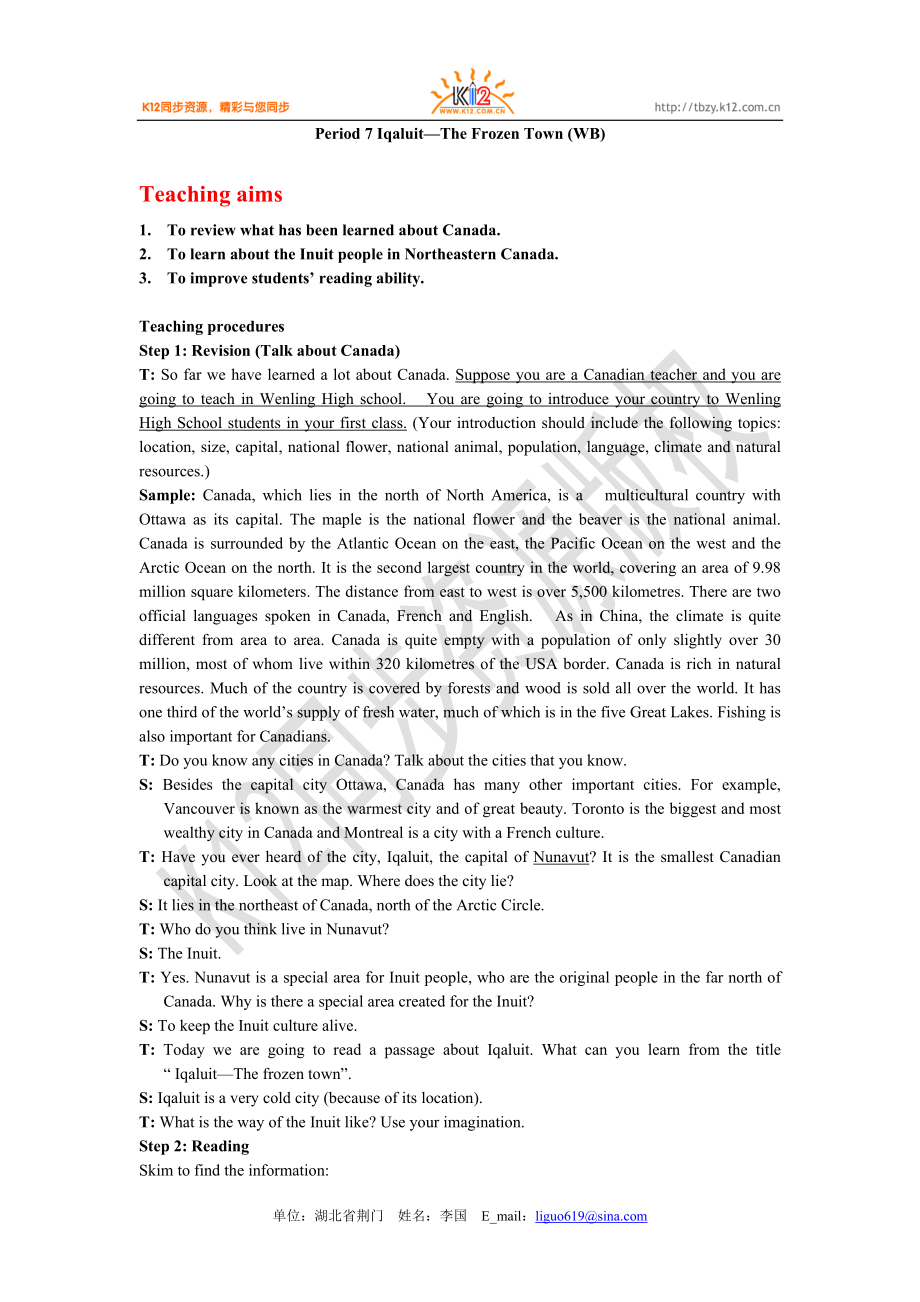《高一英語(yǔ)(下)必修三Unit 5 Period 7 課時(shí)教案》由會(huì)員分享����,可在線(xiàn)閱讀,更多相關(guān)《高一英語(yǔ)(下)必修三Unit 5 Period 7 課時(shí)教案(2頁(yè)珍藏版)》請(qǐng)?jiān)谘b配圖網(wǎng)上搜索����。
1、
Period 7 Iqaluit—The Frozen Town (WB)
Teaching aims
1. To review what has been learned about Canada.
2. To learn about the Inuit people in Northeastern Canada.
3. To improve students’ reading ability.
Teaching procedures
Step 1: Revision (Talk about Canada)
T: So far we have learned a l
2�、ot about Canada. Suppose you are a Canadian teacher and you are going to teach in Wenling High school. You are going to introduce your country to Wenling High School students in your first class. (Your introduction should include the following topics: location, size, capital, national flower, natio
3、nal animal, population, language, climate and natural resources.)
Sample: Canada, which lies in the north of North America, is a multicultural country with Ottawa as its capital. The maple is the national flower and the beaver is the national animal. Canada is surrounded by the Atlantic Ocean on t
4、he east, the Pacific Ocean on the west and the Arctic Ocean on the north. It is the second largest country in the world, covering an area of 9.98 million square kilometers. The distance from east to west is over 5,500 kilometres. There are two official languages spoken in Canada, French and English.
5���、 As in China, the climate is quite different from area to area. Canada is quite empty with a population of only slightly over 30 million, most of whom live within 320 kilometres of the USA border. Canada is rich in natural resources. Much of the country is covered by forests and wood is sold all ov
6�����、er the world. It has one third of the world’s supply of fresh water, much of which is in the five Great Lakes. Fishing is also important for Canadians.
T: Do you know any cities in Canada? Talk about the cities that you know.
S: Besides the capital city Ottawa, Canada has many other important citi
7�、es. For example, Vancouver is known as the warmest city and of great beauty. Toronto is the biggest and most wealthy city in Canada and Montreal is a city with a French culture.
T: Have you ever heard of the city, Iqaluit, the capital of Nunavut? It is the smallest Canadian capital city. Look at th
8�、e map. Where does the city lie?
S: It lies in the northeast of Canada, north of the Arctic Circle.
T: Who do you think live in Nunavut?
S: The Inuit.
T: Yes. Nunavut is a special area for Inuit people, who are the original people in the far north of Canada. Why is there a special area created fo
9、r the Inuit?
S: To keep the Inuit culture alive.
T: Today we are going to read a passage about Iqaluit. What can you learn from the title “ Iqaluit—The frozen town”.
S: Iqaluit is a very cold city (because of its location).
T: What is the way of the Inuit like? Use your imagination.
Step 2: Rea
10�����、ding
Skim to find the information:
1. Who visited the town located in the north of Canada?
2. When did she go there?
3. Where did she arrive at last? (What is the name of the town that the reporter visited?)
4. How did she reach the town?
5. Why did she visit the town?
Skan and fill in the ch
11�、art to see how much you understand about the passage.
Points in the passage
What Beth thought
Information in the passage
The temperature
How to travel
Holidays
How people live
What the Inuit do
Daylight hours
Step 3: Listening
Listen to the tape to check the stu
12、dents’ pronunciation and intonation.
Step 4: Consolidation
Complete the following passage.
Iqaluit, formerly known as Frobisher Bay, is the capital and the largest community of Canada's youngest territory (領(lǐng)土����,地區(qū)), Nunavut. Iqaluit is located 2,000 kilometres from Ottawa and is generally only ac
13、cessible(可進(jìn)入的) via aircraft, dog sled, snowmobile and some boats. Recorded history of Iqaluit dates back to 1576, when Martin Frobisher arrived at this port city. Iqaluit has a typically arctic climate, with very cold winters and short summers. It experiences 24 hours of daylight per day in June, a
14���、nd six hours per day in December. The average temperature in January is -35degrees and in July is 15degrees. Iqaluit has a population of about 6000, of which about 60% are Inuit. The Inuit are the original people of Canada, who used to live by hunting and fishing and live in movable houses and tents. But today, many Inuit are living in towns and developing business.
單位:湖北省荊門(mén) 姓名:李國(guó) E_mail:liguo619@
 高一英語(yǔ)(下)必修三Unit 5 Period 7 課時(shí)教案
高一英語(yǔ)(下)必修三Unit 5 Period 7 課時(shí)教案

